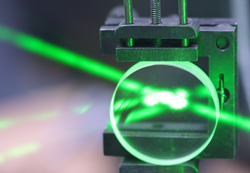New lasers for health, safety and more
The Vertigo project has developed a compact high-performance optically pumped semiconductor disk laser (OPSDL). The laser operates at a wavelength of 2.0-2.5 micrometres, enabling applications in gas detection, free-space optical communication and medical diagnostics. This technology also has a valuable security role to play in detecting dangerous chemicals and explosives and in conducting covert communications. Project partners include university, industry and government-funded research institutes together with SMEs to ensure the successful commercial exploitation of the technology. The OPSDL concept is based on a new type of semiconductor laser. It combines the advantages of conventional solid-state lasers, such as outstanding beam quality and high average output power, with the flexibility of semiconductor diode lasers. The Vertigo consortium has successfully developed long-wavelength gallium antimonide (GaSb) disk laser technology based on the semiconductor compound. This new class of high-power, high-brightness laser is a major advance over current technology and has been achieved using low-cost components thanks to the flexibility of the OPSDL format. Applications of Vertigo technology include high-speed free space optical (FSO) communication, which uses light to transmit data between two points. This may be employed when it is impractical to use fibre-optic cables. The new laser has highly sensitive gas detection capability and can be used for monitoring gases and chemical compounds in the environment. It can collect precise data for global climatic monitoring or detect hidden chemicals and explosives. An additional benefit is the use of the technology in healthcare as a sensitive, non-invasive diagnostic device and in high-throughput medical screening. The Vertigo development has successfully produced flexible, high-performance laser sources as well as addressing important issues of standardisation and cost effectiveness. The new laser technology will help monitor our changing climate, keep us safe from chemicals and explosives, and provide faster and more reliable healthcare.







